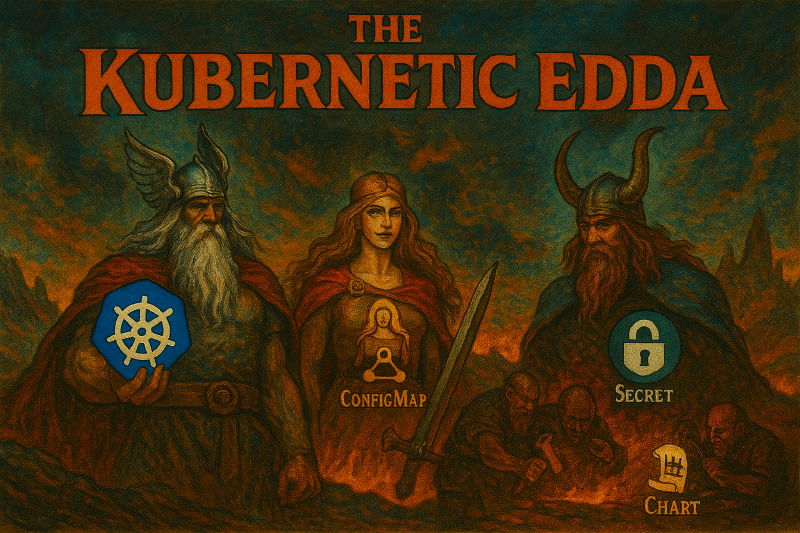In times of old, where Ymir (the tangled, pre-containerized infrastructure) dwelt, nor sand nor sea, nor nodes nor pods existed. Not declarative state nor resilience. Only EC2 instances, crontabs, manual failovers, and nginx configs like spiderwebs.
’Twas chaos—a chasm of impermanence and toil.
Then came the sons of Borr:
- Odin, the Control Plane, whose will defined the desired state and kept all in sync. Like the all-seeing one, he orchestrated the domain through abstraction and decree.
- Vili, the Scheduler, whose name means will—he placed pods upon nodes as one might cast runes, balancing fate and load.
- Vé, the API Server, the sacred interface through which all definitions were spoken and all intentions registered. He was the mouthpiece of the system and the entry point to its divine workings.
These three beheld the bloated body of Ymir, whose legacy code threatened all creation. They struck him down with blade and YAML. From his flesh they formed the nodes; from his bones, the availability zones—isolated regions of infrastructure designed to contain failure and shield the realm from cascading doom; from his blood, the VPCs and networks—virtual private clouds that defined the borders and passageways of communication, separating realms while allowing chosen flows; and from his skull, they stretched the Ingress Controller across the firmament.
Thus did the Control Plane inscribe the laws of state into the fabric of the cluster: observed and desired, continuously reconciled.
From the ashes of old, a solitary enchantress emerged: Freyja’s Mirror, a fragile Pod known as holy-api, whispering answers through RESTful incantations. She stood alone in a Namespace called Vanaheimr, noble but imperiled—spawned from imperative rituals, bound to no Deployment, anchored to a single node.
But the Norns, those who weave the fates of uptime and fault-tolerance, frowned. “This one shall fall, and no replica shall take her place. The world remembers not the ephemeral.”
So the Runekeeper was summoned.
“Take this Mirror,” said the Oracle, “and cast her anew in triplicate. Let her essence be woven into a Deployment, guarded by a ReplicaSet, self-healing and eternal. And let her bear the Seal of Containment:
allowPrivilegeEscalation: false
privileged: falseFor no container should rise with unbounded might, lest it defile the node entire.”
The Ritual
First, he whispered to the cluster, summoning a base scroll from command:
kubectl create deployment holy-api \ --image=<original-image> \ --replicas=3 \ --dry-run=client -o yaml > /opt/course/9/holy-api-deployment.yamlThen, he unsealed the scroll and carved the Oaths of Containment into the container spec:
securityContext: allowPrivilegeEscalation: false privileged: falseWith the configuration complete, he invoked the word of power:
kubectl apply -f /opt/course/9/holy-api-deployment.yamlAnd as the three replicas took form—interchangeable and fault-tolerant—the lone Pod, unguarded by any controller, was cast into the Void:
kubectl delete pod holy-api
Thus did holy-api ascend from impermanence to immortality.
And in /opt/course/9/holy-api-deployment.yaml, the new order was etched. The Control Plane nodded. Etcd remembered.
